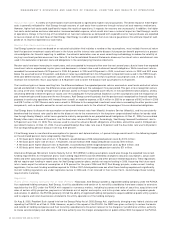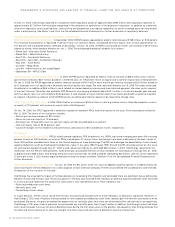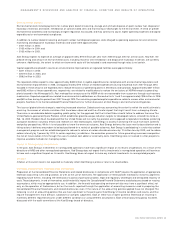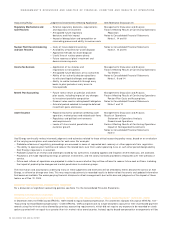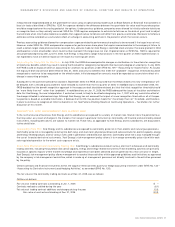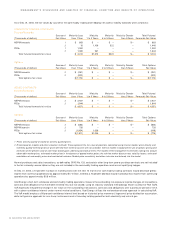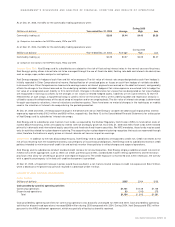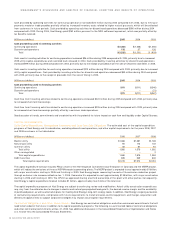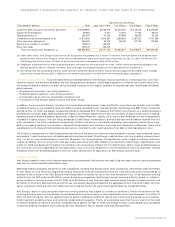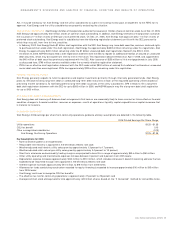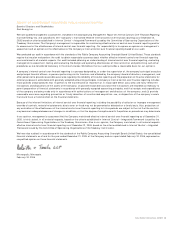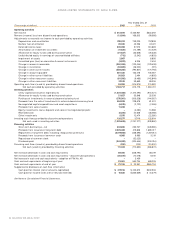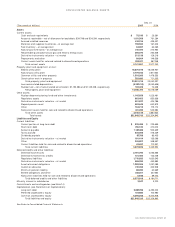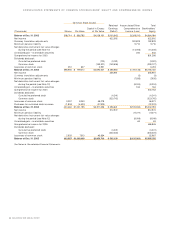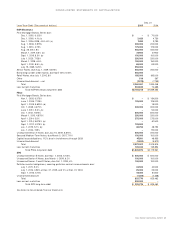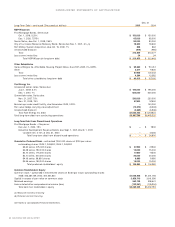Xcel Energy 2005 Annual Report Download - page 38
Download and view the complete annual report
Please find page 38 of the 2005 Xcel Energy annual report below. You can navigate through the pages in the report by either clicking on the pages listed below, or by using the keyword search tool below to find specific information within the annual report.
Upon the repeal of the PUHCA, these limitations on Xcel Energy’s financings generally will no longer apply, nor will the PUHCA restrictions
generally apply to the financings by the utility subsidiaries. However, utility financings and intra-system financing will become subject to
the jurisdiction of the FERC under the Federal Power Act. The FERC has granted a blanket authorization for certain intra-system financings
involving holding companies. Requests to the FERC to clarify its rules or grant similar blanket authorizations are presently pending before
the FERC. Xcel Energy and the utility subsidiaries are presently evaluating the specific applications that they will need to file with the FERC
due to the repeal of the PUHCA.
It is possible that in lieu of requesting authority from the FERC for intra-system financings, Xcel Energy and the utility subsidiaries may rely in
the interim on a transitional savings clause that would permit such financing transactions to the extent authorized by the SEC financing order
and so long as the conditions in the SEC financing order continue to be satisfied.
Short-Term Funding Sources
Historically, Xcel Energy has used a number of sources to fulfill short-term funding needs, including operating
cash flow, notes payable, commercial paper and bank lines of credit. The amount and timing of short-term funding needs depend in large
part on financing needs for construction expenditures and working capital. Another significant short-term funding need is the dividend payment.
As of Feb. 14, 2006, Xcel Energy and its utility subsidiaries had the following committed credit facilities available to meet its liquidity needs:
(Millions of dollars) Facility Drawn
*
Available Cash Liquidity Maturity
NSP-Minnesota $ 450 $162.7 $ 287.3 $ – $ 287.3 April 2010
NSP-Wisconsin –––––
PSCo 600 212.0 388.0 49.2 437.2 April 2010
PSCo 50 – 50.0 – 50.0 April 2006
SPS 250 82.0 168.0 12.7 180.7 April 2010
Xcel Energy – holding company 700 393.5 306.5 0.8 307.3 November 2009
Total $2,050 $850.2 $1,199.8 $62.7 $1,262.5
* Includes direct borrowings, outstanding commercial paper and letters of credit.
Operating cash flow as a source of short-term funding is affected by such operating factors as weather; regulatory requirements, including
rate recovery of costs; environmental regulation compliance and industry deregulation; changes in the trends for energy prices; and supply
and operational uncertainties, all of which are difficult to predict. See further discussion of such factors under Statement of Operations Analysis.
Short-term borrowing as a source of funding is affected by regulatory actions and access to reasonably priced capital markets. For additional
information on Xcel Energy’s short-term borrowing arrangements, see Note 3 to the Consolidated Financial Statements. Access to reasonably
priced capital markets is dependent in part on credit agency reviews and ratings. The following ratings reflect the views of Moody’s, Standard
& Poor’s, and Fitch. A security rating is not a recommendation to buy, sell or hold securities, and is subject to revision or withdrawal at any
time by the rating agency. As of Feb. 23, 2006, the following represents the credit ratings assigned to various Xcel Energy companies:
Company Credit Type Moody’s Standard & Poor’s Fitch
Xcel Energy Senior Unsecured Debt Baa1 BBB- BBB+
Xcel Energy Commercial Paper P-2 A-2 F2
NSP-Minnesota Senior Unsecured Debt A3 BBB- A
NSP-Minnesota Senior Secured Debt A2 A- A+
NSP-Minnesota Commercial Paper P-2 A-2 F1
NSP-Wisconsin Senior Unsecured Debt A3 BBB A
NSP-Wisconsin Senior Secured Debt A2 A- A+
PSCo Senior Unsecured Debt Baa1 BBB- BBB+
PSCo Senior Secured Debt A3 A- A-
PSCo Commercial Paper P-2 A-2 F2
SPS Senior Unsecured Debt Baa1 BBB A-
SPS Commercial Paper P-2 A-2 F2
Note: Moody’s highest credit rating for debt is Aaa and lowest investment grade rating is Baa3. Both Standard & Poor’s and Fitch’s highest credit
rating for debt is AAA and lowest investment grade rating is BBB-. Moody’s prime ratings for commercial paper range from P-1 to P-3. Standard &
Poor’s ratings for commercial paper range from A-1 to A-3, and Fitch’s ratings for commercial paper range from F1 to F3.
In the event of a downgrade of its credit ratings to below investment grade, Xcel Energy may be required to provide credit enhancements
in the form of cash collateral, letters of credit or other security to satisfy all or a part of its exposures under guarantees outstanding. See a
list of guarantees at Note 13 to the Consolidated Financial Statements. Xcel Energy has no explicit rating triggers in its debt agreements.
Money Pool
Xcel Energy has established a utility money pool arrangement with the utility subsidiaries and received required state regulatory
approvals. The utility money pool allows for short-term loans between the utility subsidiaries and from the holding company to the utility
subsidiaries at market-based interest rates. The utility money pool arrangement does not allow loans from the utility subsidiaries to the
holding company. NSP-Minnesota, PSCo and SPS participate in the utility money pool pursuant to approval from their respective state
regulatory commissions. No borrowings or loans were outstanding at Dec. 31, 2005. Borrowing limits are $250 million, $250 million and
$100 million, respectively. As a consequence of the repeal of the PUHCA and the recent amendments to section 203 of the Federal Power
36 XCEL ENERGY 2005 ANNUAL REPORT
MANAGEMENT’S DISCUSSION AND ANALYSIS OF FINANCIAL CONDITION AND RESULTS OF OPERATIONS


